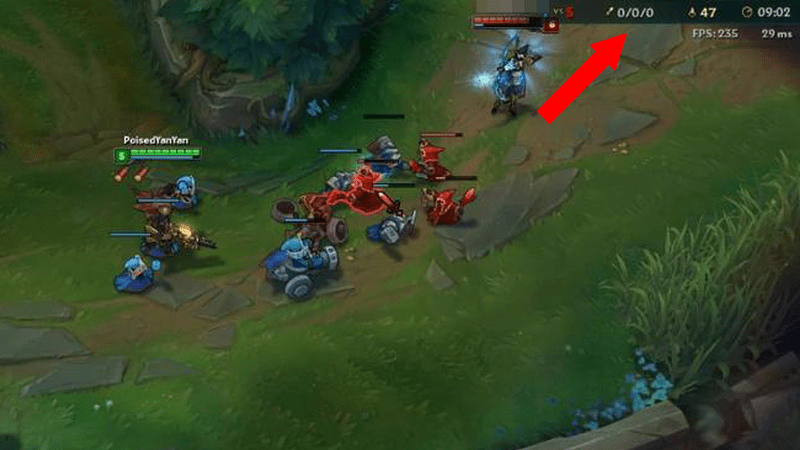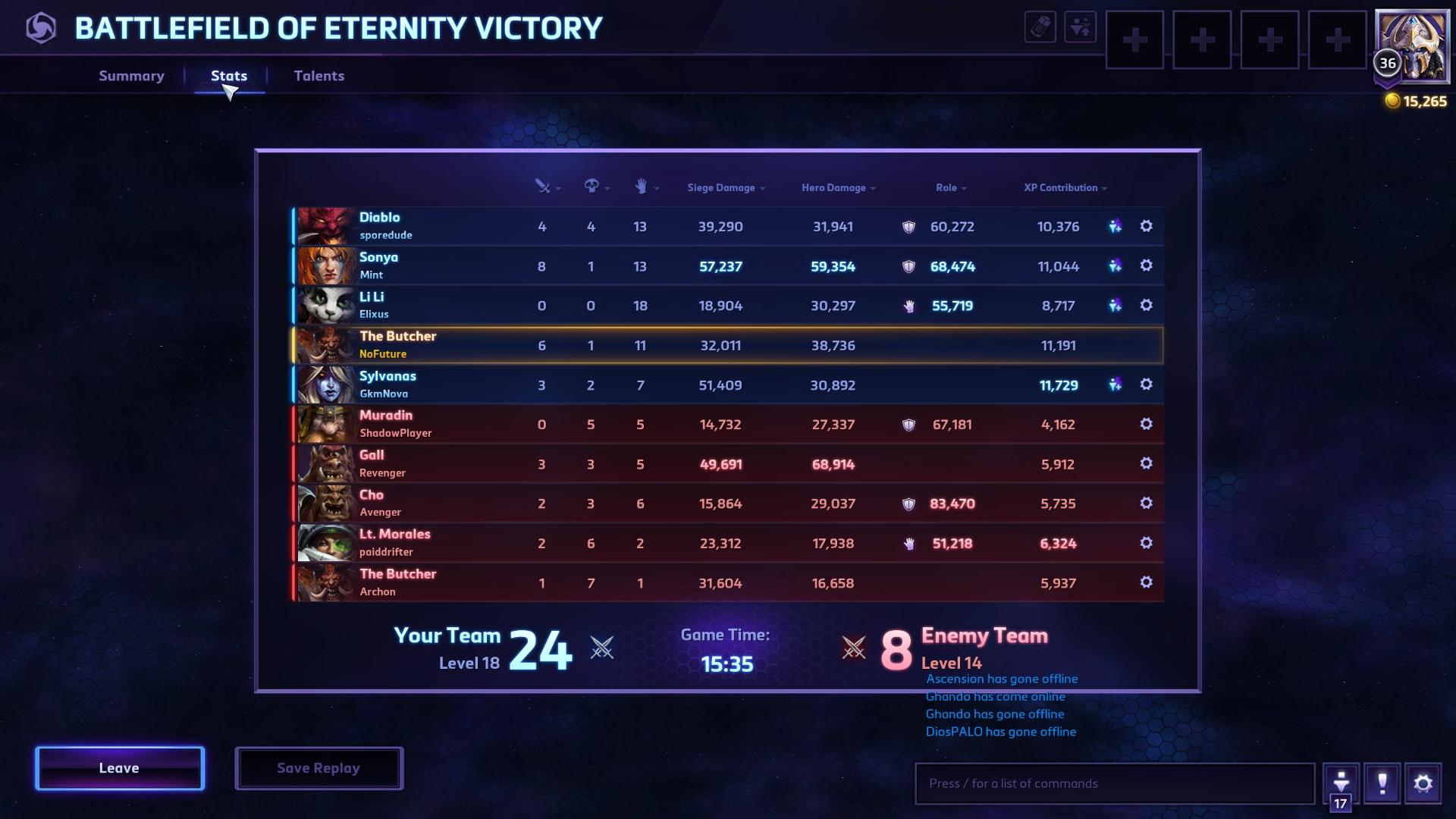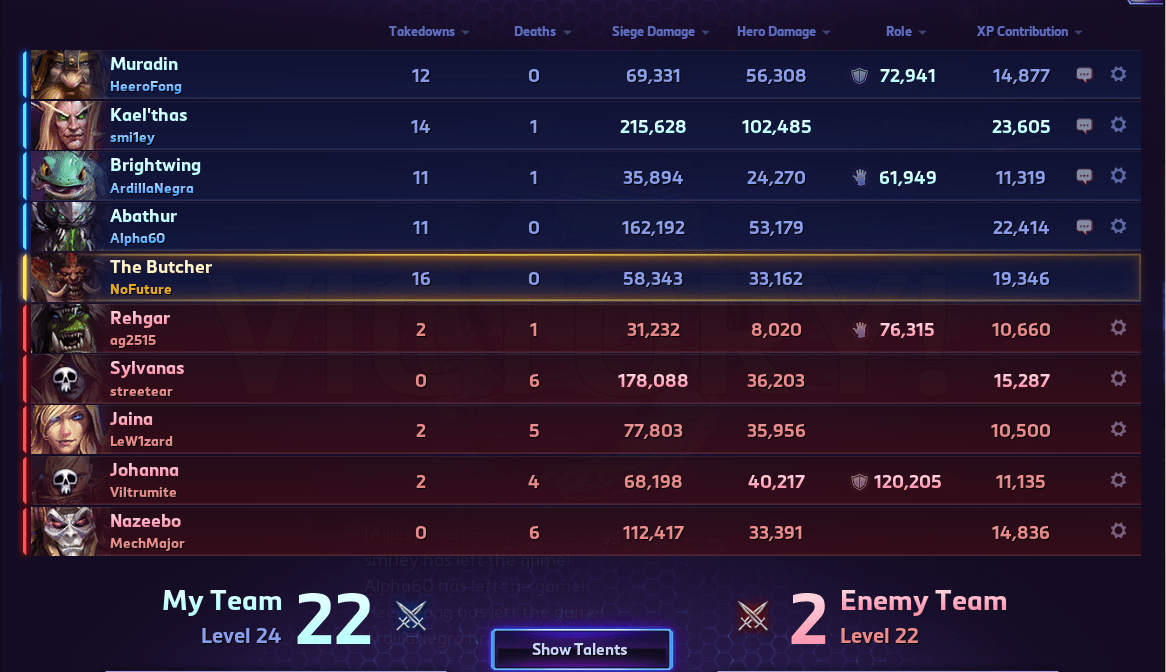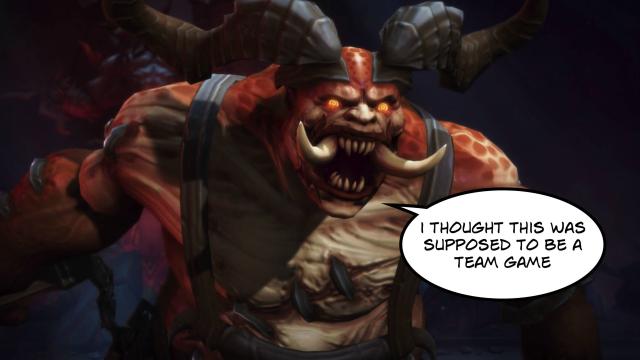Heroes of the Storm has been going through a lot of changes lately, some small, some the size of a gigantic two-headed ogre. There’s one change that’s disturbed me more and more the more I think about it. They added KDA ratios into the game. Oh god, the KDA ratio!
A KDA ratio is a very simple thing in theory. All it is is a list of three numbers in a specific order — “Kills” first, then “Deaths,” and finally “Assists.” It’s often presented in competitive online multiplayer games and then used, however inappropriately, as a way to measure a player’s performance. KDA has been a hallmark of League of Legends, Heroes of the Storm’s principle competitor in the MOBA space, for years. The in-game UI presents you with your KDA. It currently sits at the top-right of the screen along with the overall kill score for both teams, your creep score (the amount of minions you’ve killed), and the time of the match:

You still have to press “tab” to be able to see your KDA in Heroes of the Storm, so it’s not as prominent or immediately visible as it is in League of Legends. The game’s score screen now shows it as the first three numbers put next to each character’s portrait like so:

Previously, Heroes of the Storm only presented you with two numbers: deaths and “takedowns.”

Takedowns combined kills and assists into one big number. As you can see, doing so intentionally blurs the information immediately available to players. All you can see looking at this score screen is: everyone’s takedown score, and then the final kill score. There’s no way I (playing as The Butcher, the name outlined in yellow there) could have gotten 16 kills while my ally Kael’thas got 14 if our team’s final kill count was just 22. And that was the point: you couldn’t assign full credit to a single person for a kill, or see where exactly each kill in the final team score came from. In turn, you couldn’t apportion blame with an arbitrary and ever-changing standard.
This old system made much more sense for Heroes of the Storm, given the game’s peculiarities as a member of an already peculiar genre of games. One of the biggest differences between HOTS and the two other big PC MOBAs (League and Dota 2) is that it apportions experience on a team-wide level. Experience for kills, experience for destroying enemy buildings, experience for farming minions — everything is shared equally by the whole team. Everyone on a team therefore levels up at the same time and thus unlocks their different upgrades and abilities simultaneously.
Takedowns fit perfectly within this design philosophy. Just like everything else in HOTS, they are shared by all the players involved in executing a kill (or several). The system was a tad janky — sometimes it would award me with kills when I didn’t do anything in a situation. Like: literally nothing, I’d just be standing nearby, doing something completely different, when an ally assassin would suddenly pounce on some unsuspecting opponent a few feet away. Problems aside, the in-game takedown rewards were consistent with everything else about how Blizzard frames HOTS matches.
In League and Dota, experience is handled in the complete opposite way. You only get experience for your direct kills, or direct assists, which reward much less xp than kills. For better or worse, this system encourages people on a League of Legends team to play selfishly. Even when working together as a team, you have to make sure that you’re securing yourself a substantial enough chunk of xp to be able to keep playing. This dynamic is so overbearing in League that players regularly argue with each other over “kill steals,” or KS — separate teammates each insisting that they deserved to get that last kill, or if you want to be a real troll, actively trying to deny your teammates kills.
KDA ratios and their influence in League of Legends is a thorny topic — the data is often useful and instructive when watching professional games or when playing at a serious competitive level in ranked. At the same time, its very presence invites conflict. As I showed earlier this week in a detailed blow-by-blow breakdown of a massive inter-team argument in a recent League of Legends match, KDA ratios always seem to be the first thing that players jump to when they want to start antagonizing one another about who’s a better player and who’s the real noob. Once an argument starts in-game, it’s all but inevitable that people will start saying likes like, “you’re 0-3,” or, “you have no fucking kills.”
At the same time, there are merits to individual XP that justify the ubiquitous presence of KDA ratios in League of Legends. I could argue that isolating each team member’s experience actually helps motivate them to play their best and keep up with the rest of the team, the same way I could argue that sharing XP in HOTS motivates everyone to work together rather than keep looking out for their number one. It’s a surprisingly familiar debate about the merits of different economic systems and how they influence those working within. Ultimately, League and Heroes are different games. I can’t render any judgement more definitive than that.
What I can say, however, is that KDA ratios actually make sense for League of Legends because they fit within the game’s overall design philosophy. Knowing someone’s KDA is legitimately useful information in League, especially when it comes to the professional tournaments and high-level ranked player — i.e., places where players benefit from having this data at their fingertips. The deleterious effects that KDA ratios have on League of Legends’ community are thus balanced against the good things that such information provides.
From the very beginning, Blizzard has insisted that it’s doing something different with Heroes of the Storm. Something new and exciting that’s meant to shake up people’s assumptions about the MOBA genre. And what’s really and truly awesome about the game is that it has done that. Any HOTS fan who’s come from another MOBA will tell you that they feel like the shared experience, along with many other factors, helps incentivise teamworks by instilling everyone with a sense of: Hey, we’re in this together. It really shouldn’t matter who’s responsible for what kills, because these data points don’t even matter thanks to the game’s innovative design.
Heroes of the Storm is at its best when it strikes out on its own and doesn’t try to make itself fit within the genre confines that League and Dota 2 have so successfully established. Adding KDA ratios to HOTS is not that. It’s a strange appeal to a foreign system that doesn’t have a real place in Blizzard’s game.
You know what I’d much rather see in Heroes of the Storm than KDA ratios? More things like Cho’Gall, the genre-defying new hero who’s controlled by two different players at the same time. Let’s keep adding new mechanics that encourage people to play together and cooperate with one another, rather than players more tools to separate themselves from one another.

Comments
15 responses to “Adding Kill-Death Ratios To Heroes Of The Storm Was A Bad Idea”
What is wrong with kda ratio? It’s the best thing to show how much you contribute to the team. Obviously a guy with 0 kill 10 death 0 assist is the issue in a team game. If you have 0 kill 10 death and 10 assist you are still doing a good job.
Because nobody pays attention to assists in any game. In fact, I’ve seen plenty of times people using assists as an indication that someone stole their kills.
With a K/D ratio, you can have players so focused on improving their score that they don’t care about the team, or even the game.
Well that is when people dont know what kda represents. Personally to me assist is the core of the entire ratio. Kills only with no assist just means you are a dick. Death only with no assist is feeder etc. assist only players are the main supporting guys that make plays.
Letrico is right. It makes absolutely no difference. Its just a more detailed breakdown. There is no such thing as kill stealing in HOTS, EXP for the team is EXP for the team. There are so many roles to play in HOTS that the guy with the most kills isn’t always the biggest contributor. I’ve had plenty of games where a team that dominates in team fights ultimately goes down to lane pressure from specialist heroes.
I can’t speak for LoL, but what you are outlining is way too ambiguous for DotA.
DotA KDAs are fairly simple, hard carrys should have high kills and (comparatively) low assists, supports obviously are vice versa. Farming carrys have less assists but their kills stack up towards the end of the game, mid game carrys focus on kills early and pare back towards the end game.
Ok, maybe thats not incredibly simple. The point is that at any one time there will be someone who SHOULD have low assists and high kills and once again vice versa for someone else. If fights break out because people disagree on what roles should have which, or fixate on say, a support who has no kills but high assists, then that isn’t a kda problem – that’s a general ignorance problem.
Why not just keep using “takedowns” then, which is a measure of the number of kills you took part in, regardless of who got the killing blow? Isn’t that a better way to show contribution than separating kills and assists?
I was playing Cho (‘Gall) and all my kills well being stolen by ‘Gall………
I had the most assists by far but Gall had twice the number of kills.
Wow, people still play this game? It failed so miserably…
At what…
KDA ratios only work in the way suggested by the article if you’re a bad player, at least in DOTA2.
For a support hero/champion, death’s and assists are a much better indication of your contribution to the match as you shouldn’t be getting kills as a support. As long as you’re doing your job and not dying in stupid ways, nobody cares.
As for kills and deaths, if you’re playing with a half decent team, there’s a very clear pecking order in who gets kills/farm from the hardest carry (someone who makes the biggest impact with items) down to the supports who need very little more than basic boots to perform their role properly.
Even assists aren’t a great indication. As Omniknight I have a ridiculously high win-rate but a very low KDA because most of my impact is just in buffing my team and nerfing the enemy. I can deal damage and heal but my KDA seems pitiful every game.
To be honest when judging someone I look at the far right columns. If they are playing tank and have taken not much damage you know they suck. Equally when you see a KT finish the game with low DMG you know they suck to.
Kill Death ratios are one of the reasons I don’t play MOBAs. I really don’t need any more ways to have my face rubbed in how much I suck. And yeah, Heroes Of The Storm was supposed to be the game for those who wanted to tone down that hyper-competitiveness just a little bit.
The only bright side is the game mechanics haven’t changed… Kills still count to the team XP regardless of who got the last hit.
Personally I would have been happy had they left it the way they did, and maybe make individual kill counts available after the game is complete.
Yeah, this is definitely something they should never have changed.
Previously, if you finished a match with a lot of takedowns you felt you were really contributing to the team.
Now, you finish a match with 2 kills and 10 assists, you don’t feel the same. In fact you may feel the opposite.
Not only that, but it’s causing people to talk down to others about not getting enough kills and accusations of kill stealing are rampant. It’s bringing all that type of ugliness from other MOBAs in to HOTS now, which is a true shame as HOTS was always the one MOBA that didn’t have that kind of rubbish (or at the very least it was nowhere near as prevalent as it’s been in other MOBAs).